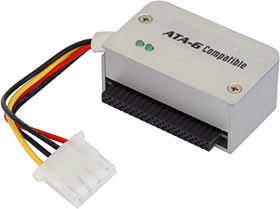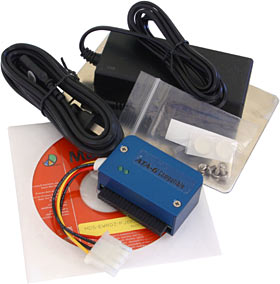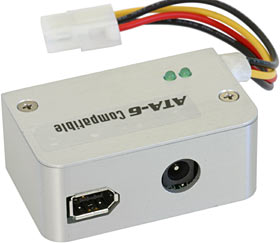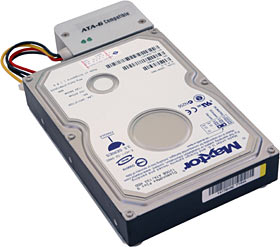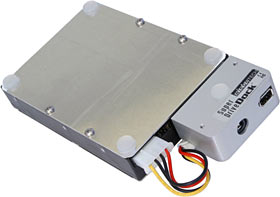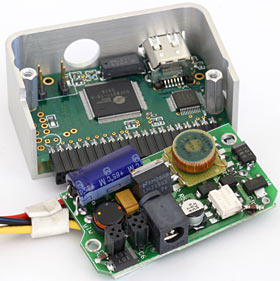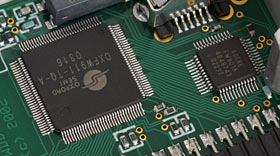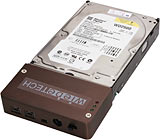
WiebeTech FireWire DriveDock and Super DriveDock
Review date: 1 September 2003.Last modified 03-Dec-2011.
FireWire is a great interface. It's got all of the good features of USB, only more so, and it's fast.
(USB version 2 now also has all of the good features of the original USB, plus speed, of course. But let's not rain on FireWire's parade just yet.)
The original version of FireWire has 400 megabit per second bandwidth. The new version that you won't yet find on anything much but G5 Power Macs manages 800 megabits per second.
Just 400 will do for most purposes, though. 400 million bits per second is 50 million bytes, which is 47.68 megabytes (one megabyte being 1048576 bytes, notwithstanding the IEC's opinion). That's quite enough bandwidth for a single hard drive, or even for three or four in a normal desktop PC setup where they're not all likely to be yammering away at once.
FireWire can also deliver quite a lot of power, in theory at least. USB's power rail is good for a flyweight half an amp at five volts - 2.5 watts. This pretty closely matches the needs of laptop hard drives; they all run from five volts natively, which is why they can work in single-wire external USB enclosures. But it's no good at all for running more demanding devices.
Full-spec FireWire can deliver serious voltage and hefty current. All the way to 40 volts at 1.5 amps, from the original spec. That's 60 watts, baby, and even after losses in DC-to-DC conversion to the 12 and 5 volt supplies that desktop drives use, it ought to be plenty to run two or three full sized drives. 3.5 inch hard drives, CD or DVD readers or writers; no problem.
So, people - would you like a simple gadget that just plugs into the back of any old cheapo Parallel ATA drive and turns it into a bus-powered FireWire device?
Behold: WiebeTech's Super DriveDock. It's a simple and elegant IDE-to-FireWire adapter. You just plug it into the back of an IDE drive set to Master and hey presto, you've got a FireWire drive.
(This is the way all FireWire drives work, by the way; some other interface, almost certainly IDE, "bridged" to FireWire by extra hardware. There's no such thing as a "native" FireWire drive.)
Here's WiebeTech's regular FireWire DriveDock kit.
The FireWire DriveDock comes with more stuff, but costs less; it sells for $US139.95, versus $US159.95 for the Super DriveDock. The only difference between the two is that the Super DriveDock can be bus powered - if the FireWire controller it's plugged into on one side can supply enough power to run the drive on its other side, then the FireWire cable is the only thing you need to connect.
The regular DriveDock comes with an AC power adaptor (100 to 240 volt, 50 to 60Hz; if your planet uses AC power, this adaptor ought to work), which you have to use to power the drive.
Except for the colour, both DriveDock units look the same from the outside. ATA plug one side, four pin drive power plug on a wire out the side, and DC and FireWire connectors on the back. The Super DriveDock has the same power socket as the regular model; you'll have to get an AC adapter for it, too, if your FireWire controller can't supply enough power for the drive you want to use.
The DriveDock casings are made from sturdy aluminium, and have power and status LEDs on top; that's all the decoration they need.
The "ATA-6 compatible" sticker on top, by the way, indicates that these DriveDocks support Ultra DMA/133 drives, with peak interface bandwidth of 133 megabytes per second. Or 133 drive manufacturers' somewhat smaller million-byte megabytes per second. It doesn't really matter, for two reasons - one, you can't move anything very close to the peak bandwidth worth of user data anyway, thanks to interface overhead, and two, only Maxtor make drives that use the "133Mb/s" speed.
The other drive makers aren't bothering with this final, largely irrelevant speed bump for Parallel ATA, but are transitioning directly to the "150Mb/s" initial speed for Serial ATA. Most IDE controller chipsets don't support full UDMA/133 speed, anyway; plug a UDMA/133 Maxtor into them and you get UDMA/100 speed.
And, in any case, FireWire 400 only has about the peak bandwidth of Ultra DMA/66, and the DriveDock's IDE side will only ever have one device connected to it. No single ATA device so far can really use even UDMA/100 bandwidth (which is why UDMA/133 isn't big news, speed-wise), and only the very fastest drives reap any real benefit from anything above UDMA/66.
The genuinely important thing about ATA-6 is that it's not just another ATA interface speed bump; it also breaks the "137Gb" size barrier, which is actually a 128Gb barrier, as I've discussed before (here and here). All of the currently manufactured high-cap consumer hard drives are ATA-6 compatible, but the 160, 200 and 250Gb models (real unformatted capacities more like 149, 186 and 233Gb, respectively) have to be, or they wouldn't work.
Using them
Setting up either DriveDock is dead simple. You take your parallel ATA drive, you set it to Master, you plug the DriveDock module into the IDE connector, and you plug the DriveDock's "Molex" power plug into the drive as well. That's it; you're done.
If you want a bit more protection for the drive, each DriveDock also comes with a simple aluminium plate to cover the vulnerable controller board.
The plate screws to the four standard holes under the drive, and you get four self-adhesive feet to stick on it, plus a spare which I stuck on the bottom of the DriveDock itself for a bit more support.
The plate doesn't attach the DriveDock in any way, though; the Dock is only held onto the back of the drive by the IDE connector. This isn't a big problem, of course - IDE cables are only held onto drives by socket-force - but I wouldn't mind an external device having a bit more solidity. A tab on the back of the plate with another screw hole or two, and matching holes in the DriveDock, would do nicely. Then you could screw the whole thing together into an unlikely-looking but surprisingly robust storage solution that wouldn't come unplugged if someone bopped it with a coffee mug.
As it stands, you could just tape the thing together, or glue it if you're more sure that you want this DriveDock and this drive to be one until death does them part.
This isn't what the DriveDocks are made to do, though. If you want a permanently FireWire-d ATA drive, you ought to buy yourself a cheap external box, which'll do the job more elegantly, and probably cost you less than even the basic DriveDock. The point of the DriveDocks is that they let you turn an ATA drive into a FireWire one with three plugs and a flick of the wrist; they let you treat ATA drives the way we used to treat disk cartridges, back in the days when SyQuest drives made good economic sense.
The simplicity of the DriveDock connection means you can swap a DriveDock between drives in, literally, seconds. Plug and unplug all the live-long day, though, and you'll sooner or later damage a connector, by simple wear and tear or by accidentally plugging it in off-by-one (that's one of the officially approved ways to destroy your computer...). So this isn't a replacement for a proper hot-swap drive cradle. But it sure is cheap and convenient, in comparison.
OK - on to the testing.
The drive in the picture above is a 120Gb Maxtor DiamondMax Plus 9; 7200RPM 120Gb drives are currently the space-per-dollar value winners in the retail market.
The sticker on this drive says it draws 670mA from the 5V rail and 960mA from the 12V one, which is 14.87 watts overall. Allow for conversion losses and 20 input watts should be plenty, right? FireWire tops out at 60 watts, so it shouldn't break a sweat running this drive.
Unfortunately, the sticker figures aren't the end of the story for drive power consumption. On startup, hard drives draw quite a lot more current, as they spin their platters up to speed. If they could take a lazy 20 seconds to become ready to use then their startup power draw could be no higher than their sticker power, but desktop users want their drives to be snappier than that (many SCSI drives, which aren't meant to spin down very often, have relatively slow startup).
Consumer drives often start and stop, because they're often installed in a computer that's turned on and off a lot, and also because of power saving settings that cause them to spin down after a period of inactivity. Long spin-up delays aren't acceptable in these situations, so the spin-up phase is quite aggressive, and draws a lot of juice.
Also, many FireWire controllers can't deliver anything like as much power as the ceiling listed in the spec. They run from the same power supply as the motherboard they're built into - or, if they're separate cards, they generally have a drive power socket that amounts to the same thing. They also lack their own beefy step-up DC to DC converters, so it would appear they're restricted to 12 volt output at best, and not at a whole lot of amps.
The Plus 9 PDF datasheet has a few power figures on it, listing more current for 5V and less for 12V when the drive's seeking; it doesn't list spin-up draw.
I tested the Super DriveDock on my Abit IC7's built-in FireWire controller. I didn't test it with a separate PCI-card FireWire controller, for two reasons.
One: Just because one FireWire card will run a particular drive from bus power doesn't mean another one will, and doesn't say much about how well another drive would work, either; neither drives nor FireWire cards come with detailed enough current draw and delivery data to be sure without empirical testing.
Two: I can't remember where I put my PCI FireWire card.
Anyway, I started out by testing the Super DriveDock with the DiamondMax. I plugged the FireWire cable in, and the drive just ticked. It was trying to spin up, but the FireWire controller wasn't delivering enough juice for that to happen.
Plugging in the power supply from the plain FireWire DriveDock solved this problem. The drive spun up fine now, and appeared as a FireWire storage device. Now that it was spun up, its current draw was lower, and so it still worked after I unplugged the power supply.
After a while, however, it spun down again, in accordance with the Windows power saving settings I was using. The power supply still wasn't plugged in. When Windows XP next wanted to look at the drive, it tried to spin it up, and failed, and became confused.
When a drive can't spin up, but is still kinda-sorta responding to commands, Windows is likely to stop being your friend in the near future. To stop being your friend in a big, serious, kiss-your-data-goodbye way. It'll cause the kind of problem that leaves your partially written review of a FireWire gadget, saved on a different drive from the one under test, as a block of unrecoverable nonsense. And does the same to the .bak file, too. And to any other file that Windows tries to write to as you shut down your computer, a process that involves lots of basic Windows components reporting errors in that fashion we all love so much, and which eventually requires you to press the reset button while the filesystem still hasn't sorted itself out.
An e-mail mailbox, a few other pending reviews and columns... all sorts of stuff, obliterated.
Gee, lucky that didn't happen to me, eh? Ha ha ha!
This isn't a problem that's very likely to befall a DriveDock user, but it's not impossible that an external DriveDock could have its power cable yanked during a work session. An unplugged FireWire cable will only cause problems if something's accessing the drive at that moment (or if something's sitting in a write buffer and hasn't been written to the drive yet), and it'll only ever cause problems with that one drive. An unplugged power cable, however, can wipe out current work all over the place back to your last proper backup, if the drive ever spins down and your OS can't figure out what to do about it after that.
Aaaanyway, the Super DriveDock didn't fly from bus power on the IC7 with the Maxtor 7200RPM drive. WiebeTech warn about this; they talk about Macs more than they talk about PCs, but they recommend 5400RPM drives for a better chance of success from bus power.
So I tried the Super DriveDock out with some other drives from my Box Of Old Stuff That Ain't Broken Yet.
First was a Western Digital Caviar 153AA, a 15.3Gb 5400RPM drive with a 5V rating of 660mA and a 12V rating of only 240mA, according to the sticker at least. That's a total of 6.18 watts.
It worked fine with the plugpack - everything I tried did. But it couldn't spin up under bus power. Bummer.
Next up was an 8Gb Quantum Fireball CR. Another 5400RPM drive, but with a substantially higher aggregate power rating, according to its sticker - only 650mA for 5V, but 720mA for 12V, for a total of 11.89W. I assumed this one'd have no chance at all of spinning up under bus power - but, stone the crows, it did!
Clearly, the sticker power ratings have nothing in particular to do with the inrush current when the drive's spinning up. The Caviar drive needs less juice when running, but more to spin up, and the FireWire controller can't provide it. The Fireball needs more when running, but its inrush is clearly low enough that it can get going under only bus power.
Next up was a Conner CFS635A, an antique from the days... well, from the days when you could buy Conner hard drives. With less than 650Mb capacity, its current market value is about that of a cup of coffee, but its 3600RPM rotational speed and exceedingly low current ratings - 400mA 5V, 125mA 12V, total 3.5 watts (this page says 5.6 watts when seeking) - made me think it'd definitely be OK from only bus power. And it was.
Drives connected via FireWire benchmarked much the same as they did when connected via ATA. Slower overall, but not by enough to matter unless you want to use the drive for swap space, serious video editing, monster database work or something else very disk intensive.
Actually, I managed to get some faster scores from the DriveDock with the DiamondMax drive, compared with connecting an identical DiamondMax to the same IDE cable as the drive from which I was copying giant test files. The shared-IDE-cable results were significantly lower.
How much lower, exactly? Search me. These tests were before that fun data-loss incident I told you about above. Which didn't happen, I remind you.
On to CDs and DVDs.
Bridge hardware isn't, generally, a good bet for CD or DVD writing, in my experience at least. Hard drives and CD and DVD readers generally work perfectly well through FireWire and/or USB bridge chips, but writing is trickier.
Well, it worked fine this time. My Pioneer DVR-105 burned both CDs and DVDs perfectly well through the DriveDock. No problems at all. Bus power was still no good - the drive looked fine until I put a disc in it, then ran out of juice and disappeared - but with the AC adaptor connected, it was perfect.
So if you want to make a portable FireWire DVD burner, a DriveDock would appear to be a great option.
It was a bit tricky actually connecting the DriveDock to the DVD-R, because the ATA and power connectors are closer together on this drive (and on various other optical drives I've seen...) than they are on most hard drives. There's no intervening jumper block. The ancient Conner hard drive I tried has the same problem; it's from the days before hard drive connector standardisation, and wears its jumper block on the front.
On drives like this, just jamming the power plug in next to the DriveDock's body works, but it isn't elegant. If you were going to make a habit of it, you could shave off the side of the DriveDock's Molex plug to make room.
I found, once again, no substantial difference in performance between the Pioneer drive connected via FireWire or via plain ATA. FireWire used about 1.5 times as much CPU as ATA, but that won't matter to pretty much anybody.
ATA always managed higher burst speeds than FireWire - getting on for twice as fast - but burst speed means even less for CD/DVD than it does for hard drives, since the only data you can shift at full interface speed is stuff going to and from the drive's cache memory. As soon as the cache is full or empty (depending on whether you're writing or reading), you're waiting for the mechanical drive components. All the burst speed in the world won't help you then.
Extras
The DriveDock packages both come with MacDrive 5, a multi-faceted Macintosh filesystem handler for Windows machines which covers pretty much every kind of storage. It allows Wintel boxes to read, write and format Macintosh media.
MacDrive is an appropriate companion to the DriveDock, as FireWire storage is a lot more popular among Mac users than Windows ones - recent Macs can even boot from FireWire devices, including the DriveDocks. MacDrive and DriveDock together make for a super-high-capacity sneakernet that a lot of people are likely to find very useful.
On the down side, neither DriveDock package comes with any FireWire cables. I also think, based on my experience, that many Super DriveDock users are likely to find themselves buying an AC adapter and wondering why they didn't get the regular DriveDock.
If you find yourself in that predicament, you don't have to buy an official WiebeTech adapter. Their one outputs 12 volts at up to three amps, according to its spec sticker; any regulated 12 volt adapter with a similar rating (or one that can pump enough current to run your drive, anyway) and the same plug (5.5mm outside diameter, 2mm pin diameter, outside negative, inside positive) should be fine. Do not use an unregulated adapter; if it's not fully loaded, it'll output more than its rated voltage, up to nearly 17 volts for a "12 volt" unit.
Inside
The DriveDock's solid and sensible design makes it easy to get into. No stupid plastic tabs, hidden screws or glue; just two perfectly visible countersunk screws.
Inside the Super DriveDock, there are two little circuit boards plugged together.
The top one's a densely populated power supply board, chiefly concerned with generating two voltages from the single input supply.
The bottom board contains the FireWire circuitry. The big chip is the bridge unit, an Oxford Semiconductor OXFW911. The little one's an Agere FW801A (PDF datasheet here), which is what connects the OXFW911 to the actual cable.
Overall
From the point of view of a PC user, the only thing wrong with the DriveDocks (once you get past the Super DriveDock's possible bus power supply issues) is that, well, they're FireWire. FireWire doesn't seem likely to ever become a dominant standard in the plug-and-go storage market. If you want a portable drive that can be accessed by the maximum number of current PCs and Macs, you should get a USB 2.0 box.
On a USB 2.0 controller, that drive will be as fast as a FireWire one, and it'll also work on older USB 1.1 systems, though only at one megabyte per second, with a following wind. But those old systems aren't likely to have FireWire, either; 17 minutes per gigabyte is better than nothing at all.
FireWire has extra features that USB can't touch, like daisy-chaining and peer-to-peer communication between devices without a computer being involved. The DriveDocks have no daisy-chain ports, though, and aren't too likely to be used in a peer-to-peer application.
If FireWire is fine with you, though, and if you don't want a full boxed external drive solution, then you'll probably love a DriveDock. FireWire is an established standard in the Macintosh world, and lots of PC motherboards now come standard with FireWire ports right there on the rear connector block - or on a separate expansion tab, or both.
If you need a middling amount of removable single-cable bus-powered FireWire storage, a Super DriveDock seems likely to give it to you for a rather reasonable price. Whether or not a drive will actually work from bus power on your computer or any other, however, is something of a crapshoot; probably not, for modern 7200RPM and faster drives, and maybe not, for 5400RPM drives. The cheaper FireWire DriveDock is a safer bet; you'll never be able to use it in bus powered mode, but you won't have to shell out for an AC adapter either.
Drives to suit the DriveDocks can be had very cheaply. Hi-ho to the auction sites, people!
Used hard drives are generally not a good idea, because you don't know where they've been or what's happened to them. Sure, they may have come from the computer of a little old lady who did nothing but check her e-mail once a week, but they may also have been the swap disk of a 32Mb Win95 office machine that's been flogging hard for 12 hours a day, five days a week, since 1996.
If you stick a used drive in your PC, even just as a secondary scratch disk, you're really asking for trouble.
If you just want carry-around storage and the world won't end if it dies, though, then cheap used drives are a great idea. Drives with useful capacities are routinely sold by reputable dealers for well under $AU50, including delivery, on ebay.com.au; $AU40 delivered for a 30Gb drive isn't hard to find. The US options are even better.
30Gb isn't a very impressive capacity for a boot drive these days, but it's still not to be sneezed at for carry-around storage. If you've got a broadband Internet connection throttled to 128 kilobits per second for uploads, it'd take you about three weeks to send 30Gb of data to someone.
Job lots of drives of unknown provenance can be had very cheaply indeed, not including delivery. Delivery can be startlingly expensive, if you're buying three dozen drives and want them packed well enough that any that are still alive will survive the postal system; the drives in question are also likely to be useless sub-gigabyte units. Not many people care about external hard drives with the capacity of a CD-R, these days.
If you manage to find 12 four gigabyte drives pulled from old office machines for $AU50 all told, the DriveDock is so plug-and-go that it'd only be the work of an afternoon to sort through them. If they all turn out to be bad, you can always spend the evening harvesting magnets out of them!
Overall, I like the DriveDocks a lot. They do what WiebeTech promise, they don't cost an awful lot, they come with useful software, and the Super model has at least a fighting chance of working with only one wire.
Recommended.
Review DriveDocks kindly provided by WiebeTech.
Big brother
The ComboDock does everything the DriveDock does, and more...
